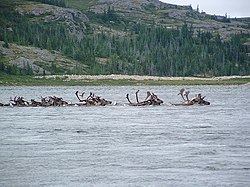Length 480 km Basin area 42,500 km² Province Québec | - elevation 181 m (594 ft) - elevation 0 m (0 ft) Discharge 590 m³/s | |
 | ||
- average 590 m/s (20,840 cu ft/s) | ||
Leaf River (French: Rivière aux Feuilles; Inuktitut: Kuugaaluk (the large river) or Itinniq (where there are spring tides)) is a river in northern Quebec, Canada, at the northern limit of the tree line. It flows from Lake Minto northeast through the Ungava Peninsula into Leaf Bay off Ungava Bay over a distance of 480 kilometres (300 mi). At the head of Leaf Bay is the Inuit community of Tasiujaq.
Contents
Map of Rivi%C3%A8re aux Feuilles, Rivi%C3%A8re-Koksoak, QC, Canada
It is possible to paddle the whole length of the Leaf River (with caution) without portaging - it doesn't contain impassable waterfalls or non-navigable rapids. The length of the river measured from Charpentier Bay to Tasiujaq is 320 kilometres (200 mi); if measured from first discernable current, it is 288 kilometres (179 mi).
The ice-free period on the river is short: about sixty days. That implies a quite low average daily temperature in the summer (approx. 10°C) generally accompanied by rain (or snow) and wind. In short, it is an environment where hypothermia can easily occur.
Tributaries
The significant tributaries of the Leaf River are:
History
Since at least the late 19th century, the river has been known by its English name "Leaf River", which was probably derived from the Arctic willow and birch trees that grow sparsely along its banks. The Hudson's Bay Company fished there for salmon and porpoises and even opened a trading post at the mouth of the river circa 1905. In the early 20th century, the French name Rivière des Feuilles was assigned, standardized to its current form Rivière aux Feuilles in 1925.
First known explorers:
1898 - Albert Peter Low
1912 - Robert J. Flaherty
1976 - Bob Davis
The Leaf River caribou herd (LRCH), is a migratory forest-tundra ecotype of the boreal population, a caribou subspecies of Rangifer tarandus caribou. Like the George River Herd, the Leaf River herd migrates between forest and tundra. Migratory caribou herds are often defined in terms of female natal philopatry or natal homing - the tendency to return to natal calving areas, in this case the Leaf River. The Leaf Herd in the west, near the coast of Hudson Bay, increased from 270 000 individuals in 1991 to 628 000 in 2001. According to the Quebec's Natural Resources and Wildlife survey, the Leaf River Herd (LRH) (Rivière-aux-Feuilles) had decreased to 430 000 caribou in 2011. According to an international study on caribou populations, the Leaf River herd could be threatened with extinction by 2080.
